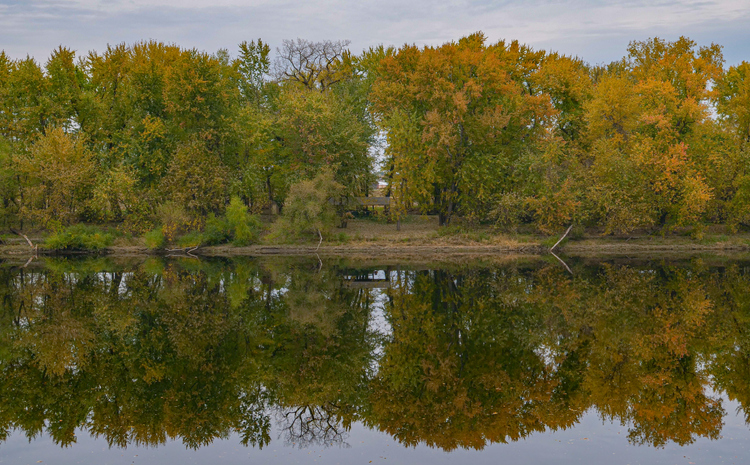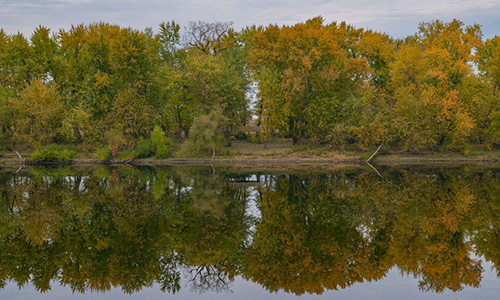
Reflections in the Connecticut River, in Northampton, Massachusetts, during October. Credit: Getty Images
In these times of stressful living, designed to contain the coronavirus, more and more people are seeking solace in nature. The fall 2020 issue of Estuary magazine contains several personal essays on this topic.
Being outside in nature today has a double benefit:
First, it dramatically dilutes the potential (compared with being indoors) for transmission of the coronavirus as long as people maintain appropriate separation.[1]
Second, irrespective of the coronavirus, nature has both physical and psychological therapeutic effects on people.[2]
In this blog I want to discuss the therapeutic benefits that nature holds for us.
It’s currently understood that physical activity, besides bolstering the physiological health of the body, causes the brain to release endorphins from the pituitary gland. Endorphins are hormones that increase one’s feelings of pleasure and happiness and suppress feelings of pain, anxiety, and depression. Many, including this author, find that getting exercise outdoors in interesting venues with changing scenery can not only be good for our physical health but also downright exhilarating. The summer 2020 issue of Estuary magazine underscores this point with an article on a guided bicycle tour along the Connecticut River. In this sense, nature can be an enabler of improved health. But this is not the whole story.
Immersing yourself in a natural outdoor setting—whether walking, hiking, birding, fishing, rowing, canoeing, kayaking, bicycling, camping, boating, taking pictures or, even just sitting quietly, meditating, and contemplating a beautiful vista and listening to its sounds—brings a sense of focus on the moment that allows you to filter out your other worries. In this state of mindfulness, also called centering or presencing, imagine that you are again a curious twelve-year-old who is approaching your environment with fresh eyes, ears, and other senses that are open for observation and learning and not closed by pre-conceived prejudices. Think about how you fit with your surroundings and how your surroundings are at one with you. Think about the solidity that nature provides: the sure knowledge that the seasons will rotate, that the River will continue to flow, and that the plant and animal life you see, including yourself, will adapt to changing circumstances. I find that rivers are particularly attractive venues because they can range from quiet, lazy currents—that promote reflection—to noisy rapids and waterfalls—that evoke wonderment; and rivers can be viewed from perspectives that span from water level to high vantage points on the hills that usually surround them. The accompanying photographs show the Ottauquechee River tributary in Woodstock, VT, and Turners Falls on the Connecticut River in Montague, MA. The features of these water courses speak for themselves and what it would be like to contemplate each subject from the actual location of the photographer.
In addition to the personal essays mentioned above, the fall 2020 issue of Estuary magazine contains Chris Zajack’s photographic essay about the Fourth Connecticut Lake, the source of the Great River that is today called the Connecticut River. Chris’s vibrant photographs vicariously place you, the reader, in a spectacularly beautiful outdoor setting. Of course, you can’t smell the pine forest, breathe the clean, crisp air, or feel the morning dampness from an overnight rain, but you can identify with what Chris might have experienced by recalling your own exposure to a similar environment. Perhaps his photo essay will entice you to find, explore, and appreciate your own special outdoor places. Your mental well-being will thank you.
So far I have been discussing what nature can do for you. In 1898 Mabel Osgood Wright founded the Connecticut Audubon Society on the premise that by participating in inspiring outdoor experiences in nearby environments, people would become motivated to help nature. Her initial focus was helping to mobilize a groundswell of public opinion against the millinery industry’s harvesting of bird feathers and other parts for women’s hats because of the resulting devastation on bird populations, especially those of white herons and egrets. Today humans must continue to help nature by compensating for well over a century of environmental insults. The path to engagement, however, remains the same: inspirational outdoor experiences, education, and successful conservation stories to forge emotional connections with nature and to galvanize conservation action.
Along the Connecticut River watershed, you will find countless outdoor venues at parks, forests, boat launches, and sanctuaries operated by the watershed states and by non-profit organizations such as land trusts and conservation groups. Nearby you can find sources of food and overnight accommodations. Many of these entities have maps of their trails and interpretative signage on the trails so that you can learn about the history and typology of the area. The watershed states of New Hampshire, Vermont, Massachusetts, and Connecticut all maintain websites that describe the locations and facilities of their parks.[3] You can find land trusts in the directory of land trusts for each of these states;[4] in fact, the fall 2020 issue of Estuary magazine will offer an introductory article about land trusts. And the Audubon societies of these states post websites that pinpoint their sanctuaries,[5] most of which are havens for birdwatching. To expand your outdoor experience, you might wish to participate in some of the programs also described in the websites listed in the footnotes.
At the least, consider subscribing to the magazine, if you are not already a subscriber. Our compilation of fascinating articles for Connecticut River enthusiasts is growing, and you will not want to miss any of them nor opportunities both to benefit from and to help nature in the Connecticut River Valley.
[1] Bromage, Erin S., https://www.erinbromage.com/post/the-risks-know-them-avoid-them
[2] Adams, Jill, “The Nature Antidote,” Audubon Magazine, Winter 2019, p. 36
[3] New Hampshire (nhstateparks.org), Vermont (vtstateparks.com), Massachusetts (portal.ct.gov/DEEP/state-parks/connecticut-state-parks-and-forests).
[4] Land Trust Directories: NH(findalandtrust.org), MA(massland.org), CT (ctconservation.org)
[5] Audubon Websites: nhaudubon.org, vt.audubon.org, massaudubon.org, ctaudubon.org

